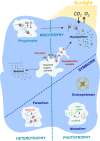How mutualisms arise in phytoplankton communities: building eco-evolutionary principles for aquatic microbes
- PMID: 27282316
- PMCID: PMC5103174
- DOI: 10.1111/ele.12615
How mutualisms arise in phytoplankton communities: building eco-evolutionary principles for aquatic microbes
Abstract
Extensive sampling and metagenomics analyses of plankton communities across all aquatic environments are beginning to provide insights into the ecology of microbial communities. In particular, the importance of metabolic exchanges that provide a foundation for ecological interactions between microorganisms has emerged as a key factor in forging such communities. Here we show how both studies of environmental samples and physiological experimentation in the laboratory with defined microbial co-cultures are being used to decipher the metabolic and molecular underpinnings of such exchanges. In addition, we explain how metabolic modelling may be used to conduct investigations in reverse, deducing novel molecular exchanges from analysis of large-scale data sets, which can identify persistently co-occurring species. Finally, we consider how knowledge of microbial community ecology can be built into evolutionary theories tailored to these species' unique lifestyles. We propose a novel model for the evolution of metabolic auxotrophy in microorganisms that arises as a result of symbiosis, termed the Foraging-to-Farming hypothesis. The model has testable predictions, fits several known examples of mutualism in the aquatic world, and sheds light on how interactions, which cement dependencies within communities of microorganisms, might be initiated.
Keywords: Eco-evolutionary dynamics; Foraging-to-Farming hypothesis; metabolite exchange; metagenomics; microbial communities; mutualism; phytoplankton; vitamins.
© 2016 The Authors Ecology Letters published by CNRS and John Wiley & Sons Ltd.
Figures





References
-
- Alldredge, A.L. & Silver, M.W. (1988). Characteristics, dynamics and significance of marine snow. Prog. Oceanogr., 20, 41–82.
-
- Amin, S.A. , Hmelo, L.R. , van Tol, H.M. , Durham, B.P. , Carlson, L.T. , Heal, K.R. et al (2015). Interaction and signalling between a cosmopolitan phytoplankton and associated bacteria. Nature, 522, 98–101. - PubMed
-
- Azam, F. , Fenchel, T. , Field, J.G. , Gray, J.S. , Meyer‐Reil, L.A. & Thingstad, F. (1983). The ecological role of water column microbes in the sea. Mar. Ecol. Prog. Ser., 10, 257–263.
Publication types
MeSH terms
Grants and funding
LinkOut - more resources
Full Text Sources
Other Literature Sources

